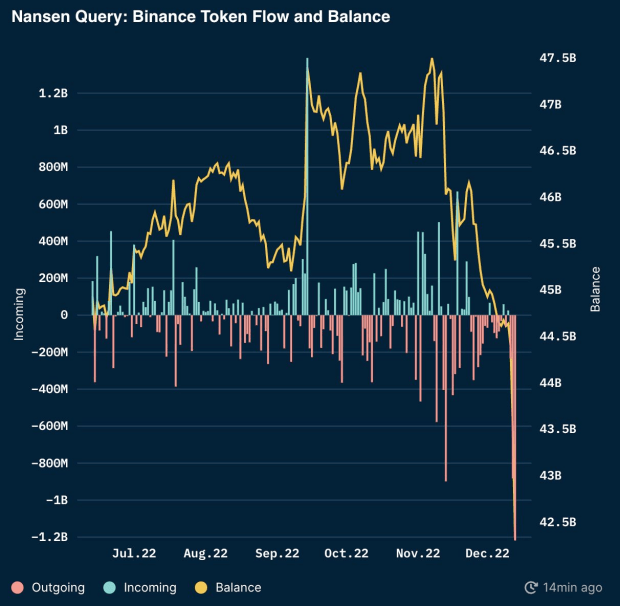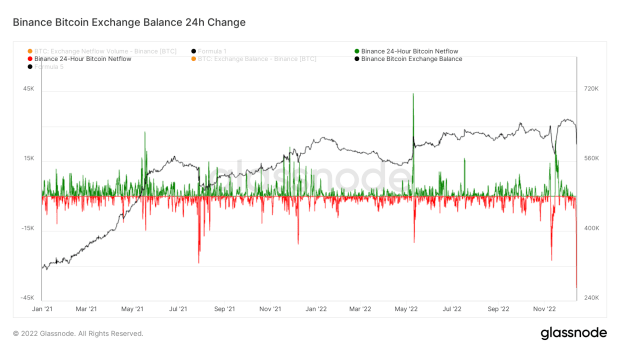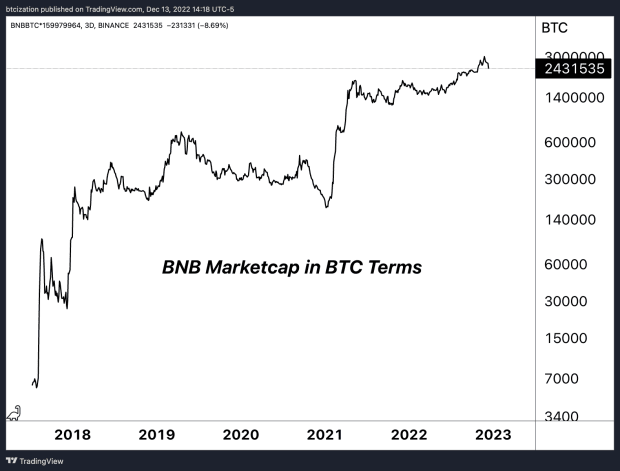- December 16, 2022
- Posted by: admin
- Category: BitCoin, Blockchain, Cryptocurrency, Investments
Binance’s bitcoin balance sees its largest one-day outflow ever and the price legitimacy for the exchange-native BNB token is called into question.


The below is an excerpt from a recent edition of Bitcoin Magazine Pro, Bitcoin Magazine’s premium markets newsletter. To be among the first to receive these insights and other on-chain bitcoin market analysis straight to your inbox, subscribe now.
Binance: FUD Or Legitimate Questions?
By far, one of the biggest winners in the aftermath of the FTX collapse has seemed — on the surface — to be Binance. After only having 7.82% market share of the bitcoin supply on exchanges in 2018, their share is now 27.50% despite a much broader trend of bitcoin supply leaving exchanges. The bitcoin balance on Binance now totals 595,864 BTC, which is 3.1% of outstanding supply, worth $10.58 billion. This bitcoin belongs to their customers and reflects a growing trend in market share over the last few years that has made Binance the largest bitcoin and cryptocurrency exchange in the world.
Binance now controls approximately 60% of the spot and derivatives volume in the entire market. It’s hard to see how any exchange in the space can be a “winner” in the current market conditions, but one could make the case for Binance, with the exchange’s growing strength in a decimated industry. On top of that, Binance’s BNB token, the native currency of Binance’s own Ethereum-competing Layer 1 blockchain, is still one of the better performing tokens when valued in bitcoin terms this year.
Yet, is this recent “strength” everything that it seems or is it a facade? We’ve learned over the last month that no company is safe in this industry right now (especially exchanges) and questions are growing around Binance’s practices, solvency, BNB token value and the overall state of their business over the last few weeks. Is it FUD or legit? Let’s try to break some of it down, addressing the concerns through an objective and skeptical lens.
Binance Flows
We’ve seen significant outflows from Binance across different various tokens and bitcoin when looking at both Nansen and Glassnode tracking. Across ETH and ERC20 tokens, Binance saw $3 billion leaving the exchange in its largest single-day outflow since June. Across Nansen total wallet tracking, all Binance balances are estimated at $62.5 billion with around 50% of those balances in stablecoins across BUSD and USDT.

According to Glassnode, the total bitcoin exchange balance on Binance is down around 6-7% over the last day, after reaching a peak on December 1. Although balances remain above 500,000 bitcoin and Binance has shown a rising trend of bitcoin balances on the platform this year, this is a significant move for outflows in just 24 hours. As a general comparison, the trend of bitcoin exchange balances was a much different story for FTX, whose balance had been falling heavily since June. Binance outflows over the last couple days are a bit alarming and raise questions: Is this a one-off event and just business as usual or is this the start of something more?

Readers can track the on-chain addresses provided by Binance for free here.
The main cause for concern is not whether Binance has any bitcoin/crypto or not. We can transparently see that the firm controls tens of billions worth of crypto assets. What isn’t exactly clear, similar to FTX, is whether the firm has commingled users funds or whether the firm has any outstanding liabilities against user assets.
Binance CEO Changpeng Zhao (CZ) has said that the firm has no liabilities with any other firms, but as recent months have shown, words don’t mean all that much. While we are not claiming that CZ is lying to the public about the state of Binance finances, we have no way to prove otherwise.
CZ’s response as to whether the company was going to audit liabilities against user assets was, “Yes, but liabilities are harder. We don’t owe any loans to anyone. You can ask around.”
Unfortunately, “ask around” isn’t a satisfactory enough answer for an ecosystem supposedly built around the ethos of “don’t trust, verify.”
While there is no doubt that Binance is an industry giant in the crypto derivatives industry, how do we know the firm isn’t doing similar things as past actors in regards to trading against clients using user funds and/or proprietary data. Things like the former Chief Legal Officer of Coinbase departing Binance U.S. last summer after just three months as the CEO leaves one with many questions.
To add to our skepticism, the price of the Binance exchange token BNB is near all-time highs in bitcoin terms, appreciating an astounding 828% against bitcoin in the last 785 calendar days.

The coming weeks will be full of headlines around the state of global crypto regulation in a post-FTX world. In a 48-hour period, Reuters published news stating that the U.S. Justice Dept is split over charging Binance, Binance withdrawals for bitcoin and aggregate stablecoin pairs have hit all-time highs and the BNB exchange token has fallen 10% relative to bitcoin.
Out of an abundance of caution, we will continue to urge readers operating on any centralized exchange — of which Binance is most definitely included — to look into self custody solutions. There have been far too many instances of incompetence and/or misconduct from exchanges.
It’s not that we don’t trust CZ or Binance, it’s the fact that we don’t trust anyone.
The whole point of bitcoin is we now have an asset that is truly the liability of no one. Verify the ownership of an open distributed network with cryptography; don’t trust permissioned IOUs. With the mix of regulatory concerns about the global crypto derivatives industry, a questionable exchange token with unbelievable relative performance over the last two years and a shaky proof-of-reserves attestation — that was incorrectly claimed to be an audit and had industry CEOs raising eyebrows — we find the need to urge our readers to evaluate their counterparty risk.

